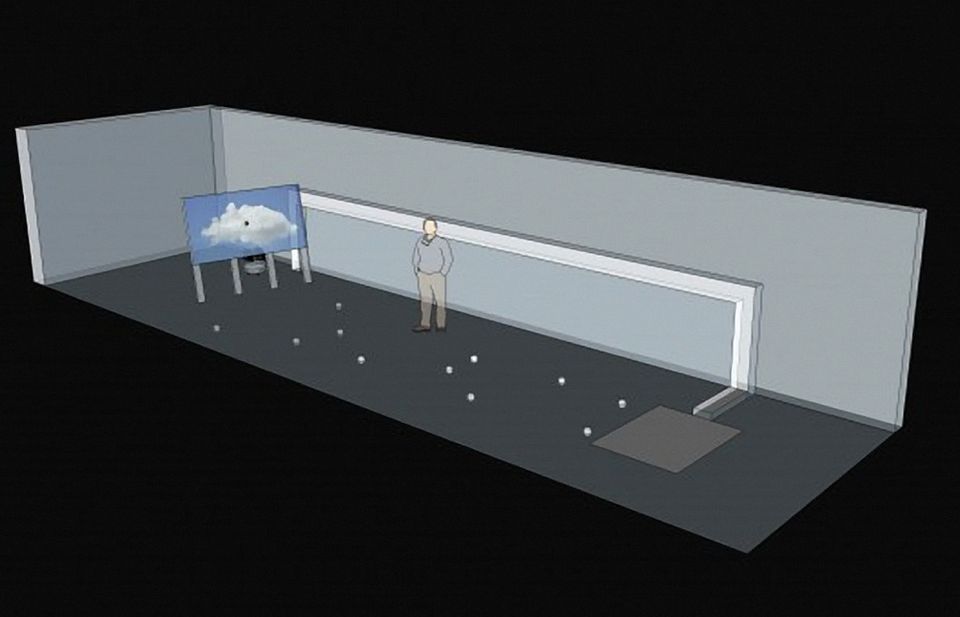
Multimedia artist and sculptor Brian Davis rounds out this spring's Luce Artist Talks series on Saturday, May 7 at 1:30 p.m. The Luce Artist Talks series brings in local artists to discuss their current projects in relation to the objects on view in our Luce Foundation Center. Davis will speak about his most recent project, Try and Try Again, which combines projected images, ping pong balls, and visitor participation. This series is presented in collaboration with CulturalDC's Flashpoint Gallery.
Eye Level: Can you talk a little bit more about how skateboarding and skate culture influenced your decision to become an artist?
Brian Davis: My friends and I were always making and fixing things. We built ramps, clubhouses, and took apart our bikes and skateboards on rainy days. I think this, and the fact that both of my parents were makers (my mother sewed and crafted, and my father was an airplane mechanic and had a garage full of tools) led me to my work where I repurpose things, tinker, and build.
EL: Which American artists (living or dead) have the biggest influence on your most recent work?
BD: A couple of professors in graduate school had a lasting impact on my thinking. Sergio Vega and Will Pappenheimer at the University of Florida were very influential. And ever since I built a modified replica of a Bruce Nauman's A Cast of the Space Under My Chair (one which Rachael Whiteread also riffed on) I have counted them as my favorites.
EL: You wrote, "Connecting two or more unrelated entities allows for a tension between what is expected and what can transpire." Do you remember a time when the outcome was so vastly different from what you expected?
BD: I'm always surprised by the variety of reactions an installation can produce. In 2005, I installed Pedestal in an outdoor wooded area by Winthrop University. Pedestal was an illuminated disco dance floor where the light-run patterns where activated by the ambient sounds around the space. One night while teaching ceramics class, I look up and see someone breakdancing on the floor with no one else around. I thought viewers would focus on how the sculpture interacted with the world around it, but in actuality they used it for their own performances.
EL: You mentioned Try and Try Again is an experiment. How do you know if one of your many ideas is worth pursuing?
BD: I think this is the most stressful part of art making. But when I find myself visiting and revisiting an idea, I know it's something I have to pursue.
EL: You've worked across a lot of mediums already. What is something you haven't tried yet, but might like to?
BD: I'm interested in performance art —the way it is ephemeral but can have a lasting impact. I'm especially drawn to Roman Signer's work. It's something that I've been thinking about incorporating more into my own work.
EL: SAAM was one of the first art museums to acquire video games, and our exhibition The Art of Video Games, recently finished a 3½ year-tour around the country. Video games and other media arts are something that clearly interest you. Can you talk a little bit about video games as art?
BD: I grew up during the rise of video games where my earliest digital experience was playing a Commodore 64. I leveraged my nostalgia for that time to create UNMAN-A. I used a restored Atari arcade cabinet to house a video game I developed. In this video game/artwork, the viewer plays as Bruce Nauman in 4 of his iconic video works and periodically the viewer would be abducted to fight space invaders. Losing yourself in a process (like one can imagine Nauman losing himself in the making of a durational video like slow angle walk) struck me as incredibly similar to playing a video game where the process of playing is the most important.
When playing video games, I often wonder, how can I use this space? I say the same thing when making an installation.
Please join us on Saturday, May 7 at 1:30 p.m. for Brian's talk. Afterward, guests are invited to head across the street to Flashpoint Gallery to experience Try and Try Again for themselves.


















